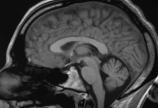Brain research sheds light on a mystery

A breakthrough in brain research has promising implications for health and may lead to new answers about depression, attention-deficit hyperactivity disorder (ADHD) and Parkinson’s disease. In a recent study, University of Victoria cognitive neuroscientist Clay Holroyd—with post-doctoral fellow José Ribas-Fernandes and PhD student Danesh Shahnazian from UVic, and colleagues Tom Verguts and Massimo Silvetti from Ghent University—brings researchers one step closer to a better understanding of a mysterious area of the brain located deep in the cerebral cortex.
The function of the human midcingulate cortex (MCC) has remained elusive to researchers despite decades of investigation and debate. The MCC appears to help sustain the execution of difficult or more mundane tasks, such as doing homework or balancing a budget, and without it, people might choose to do something easier or more enjoyable. But isolating exactly what it does is difficult to identify since the MCC is activated by most events in most tasks.
“This question has been called a ‘holy grail’ because, despite 25 years of study, no one really knows what this critical area of the brain actually does,” says Holroyd. “Our study illustrates a promising new way to understand what the MCC does, which is important because dysfunction of this brain area is implicated in a variety of neurocognitive disorders including Parkinson’s disease, ADHD and depression.”
The researchers used a computational model to predict the functions of the MCC while people performed a series of daily tasks on a computer, such as making tea or coffee, while their brains were scanned using neuroimaging. The results of an innovative data analysis technique showed that the MCC tracks the progression of a task during its execution, which is encoded as complex patterns of activity across the brain area.
Holroyd infers that when the MCC is engaged, people stay on task and avoid temptation or distraction.
The peer-reviewed paper, “Human Midcingulate Cortex Encodes Distributed Representations of Task Progress,” will be published in the Proceedings of the National Academy of Sciences of the United States of America.
This work was supported in part by the Natural Sciences and Engineering Research Council, in addition to other funding.
-- 30 --
Photos
Media contacts
Clay Holroyd (Dept. of Psychology) at 250-853-3910 or holroyd@uvic.ca
Anne MacLaurin (Social Sciences Communications) at 250-217-4259 or sosccomm@uvic.ca
Tara Sharpe (University Communications + Marketing) at tksharpe@uvic.ca
In this story
Keywords: psychology, health, research
People: Clay Holroyd, Jose Ribas-Fernandes, Danesh Shahnazian




